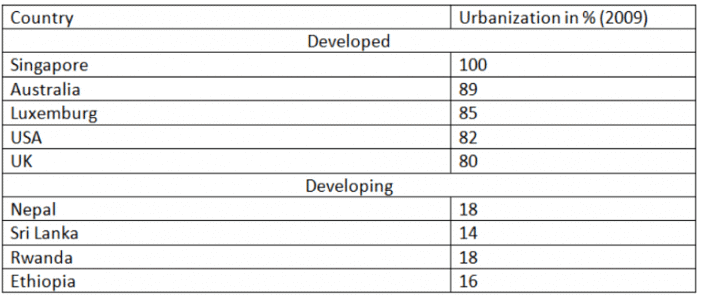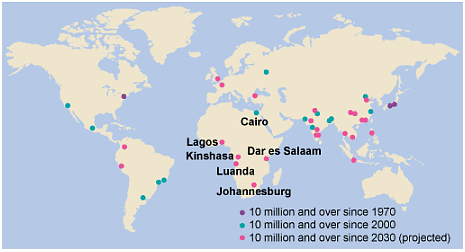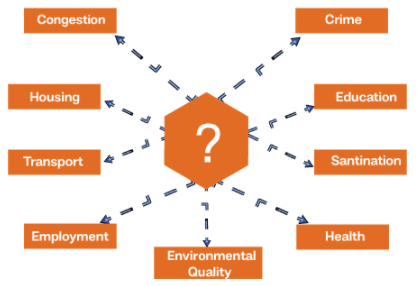Problems of Urbanisation & Remedies | Geography Optional for UPSC (Notes) PDF Download
| Table of contents |

|
| What is urbanization? |

|
| Major causes of urbanization |

|
| Remedies for Urbanization |

|
| Frequently Asked Questions (FAQs) of Problems and Remedies of Urbanization |

|
What is urbanization?
- Urbanization generally refers to the increasing concentration of a territory's population in towns and cities, leading to urban growth and development. It is commonly associated with demographic changes, where a higher proportion of the population starts living in urban areas and concentrating in larger settlements. This results in a mostly urbanized society with a majority of the population residing in a few large urban centers.
- Urbanization is closely linked to migration, which is a significant contributor to urban growth. It is also connected to structural changes in society brought about by the development of capitalism. Cities serve as hubs for production, distribution, and exchange processes, benefiting from economies of scale and scope that arise from agglomeration. Therefore, urbanization is a crucial component of industrialization and development, although it can sometimes lead to over-urbanization.
- In addition to demographic and structural aspects, urbanization also entails behavioral changes. Urban areas, particularly larger cities, are centers of social transformation. People's values, attitudes, and behaviors are influenced by the urban environment, a phenomenon known as urbanism. New forms of culture, architecture, and lifestyles emerge in urban settings and then spread through the urban system via diffusion processes.

- The three-part model of urbanization focuses on demographic change as a dependent variable within a process driven by structural factors. This model is especially relevant for analyzing modern capitalism. It's important to note that significant urban growth and urbanization took place in other regions, such as Asia, long before the industrial revolution and the rapid urbanization seen in the North Atlantic area during the 19th and 20th centuries.
- Urban growth is not exclusive to industrial societies, as large settlements have also been observed in other types of economic systems. Additionally, rapid urban growth is currently happening in many parts of the developing world, as people migrate to cities in search of better economic and social opportunities compared to those in smaller towns. This demonstrates that demographic urbanization can happen in various contexts, and what is typical for one location or time period may not be applicable to others.
[Question: 773050]
Urbanization Definition
- Any places having municipality, corporation, cantonment board, or notified town area committee. All the other places which satisfy the following criteria:
(i) A minimum population of 5000 persons ;
(ii) At least 75 % of male main working population engaged in non-agricultural pursuits ; and
(iii) A density of population of at least 400 persons per square kilometer.
Spatial pattern of urbanisation


- Developed countries are characterised by high level of urbanisation, while the developing countries have low level of urbanisation. But the urban growth rate of developing countries is very high, in spite of very high urban annual growth rate; many developing countries have low level of urbanisation.
- This shows the sharp difference of urbanisation between the developed and developing countries.
- Global urban population is growing at rapid rate from 17% in 1951 to 20% in 2001 and expected to increase 41% in 2020.



Major causes of urbanization
- The industrial revolution played a significant role in urbanization, as it led to the emergence of large manufacturing centers and attracted people from rural areas to urban locales. People sought work in the modern sector, which supported national economic development and signified the shift from an agricultural economy to a non-agricultural one.
- Job opportunities are abundant in major cities, drawing individuals from smaller towns and villages. The availability of transportation also makes it easier for people to relocate and reside in urban areas.
- Migration is a primary cause of rapid urbanization, with rural-urban, urban-rural, and rural-rural migrations all playing a role. Urban-urban migration refers to people moving from one city to another, either due to being forced out of their rural communities by poverty or being drawn to the allure of city life. A combination of these push and pull factors often drives people to migrate to cities.
- Infrastructure facilities in urban areas also contribute to urbanization. As agriculture becomes more efficient, cities grow by absorbing the workforce from rural areas. Industries and services expand, creating higher value-added jobs and leading to economic growth. The geographic concentration of these productive activities in cities generates agglomeration economies, which further boosts productivity and growth. This, in turn, increases income and demand for agricultural products in urban areas.
Problems in developed countries
Developed countries face various problems, including urban sprawl, which refers to the expansion of urban areas and the spread of urban culture. This phenomenon leads to several issues, such as:- Reduction in agricultural land: As urban areas expand, more agricultural land is used for construction purposes. For example, in the UK, over 15% of fertile agricultural land is now covered by built-up areas. This has contributed to food shortages in Western Europe.
- Impact on the agricultural economy: The blending of rural and urban spaces can harm the agricultural sector in the long run.
- Increased transportation costs: As urban areas spread, transportation distances grow, leading to higher costs.
- Pollution in rural areas: Urban pollutants are increasingly reaching rural communities.
- Declining municipal revenue: As urban sprawl continues, municipalities may struggle to maintain their revenue streams.
- Vacant housing issues: Urban sprawl can result in a higher number of vacant properties.
- Environmental degradation: Industrial complexes remain in urban areas, contributing to environmental issues such as air pollution, acid rain, and temperature increases, which can lead to health problems.
- Demographic challenges: Urban sprawl can lead to an aging population in urban centers, resulting in a labor shortage. This has led to many developed countries loosening their immigration policies to attract new workers. For example, Australia abandoned its White Australian policy, which previously only allowed white immigrants, in 1975.
- Changes in family structure: As more people move to urban areas, traditional family structures are being replaced by nuclear families, resulting in potential social instability in European societies.
Problems in developing countries
- Population explosion: Developing countries often experience rapid population growth, particularly in large urban centers such as metropolitan and capital cities. This is due to both rural-urban and urban-rural migration. Capital cities are attractive for various social and political reasons, as well as the presence of industrial complexes that benefit from better infrastructure and market access.
- Environmental degradation: Developing countries face numerous environmental challenges, including:
- Slum growth: Rapid urbanization often leads to the expansion of slums with poor living conditions.
- Housing shortage: There is often a lack of adequate and affordable housing in urban areas.
- Inadequate public utility services: Many developing countries struggle to provide essential services such as water, electricity, and sanitation.
- Urban poverty: High levels of poverty persist in urban areas, leading to social and economic disparities.
- Pollution: Rapid urbanization and industrialization contribute to increased pollution levels.
- Unplanned land use: Many developing countries lack proper urban planning, resulting in haphazard land use.
- Transportation issues: Insufficient transportation infrastructure in developing countries often leads to overcapacity, resulting in problems such as road accidents and traffic congestion. For example, according to the World Disaster Report, Ethiopia has the highest number of fatal accidents per 10,000 licensed vehicles (though this information may require updating).
- Uncontrolled urban expansion: Developing countries often experience rapid and unplanned urban sprawl, with settlements growing outside of city limits. This can lead to a range of problems, such as:
- Urban sprawl: Unplanned urban expansion can result in the inefficient use of land and resources.
- Congestion: Rapid urbanization can lead to increased traffic and overcrowded living conditions.
- Shortage of housing: As cities expand, demand for housing often outpaces supply, leading to a shortage of adequate and affordable homes.
- Vertical expansion: In response to limited land availability, cities may grow vertically, leading to the construction of high-rise buildings and other structures.
- Growth of slums and substandard housing: As urban populations grow, so do the number of slums and poor-quality housing.
- Illegal settlements: Unplanned and unregulated urban growth can lead to the formation of illegal settlements, which often lack basic services and infrastructure.
In summary, while urbanization itself is not inherently problematic, unsustainable and unplanned urbanization creates numerous challenges for developing countries, including urban sprawl, congestion, housing shortages, and the growth of slums and illegal settlements.


Some additional topics
- Counter-urbanization refers to the phenomenon of large numbers of people moving from urban areas to the surrounding countryside or rural areas. This demographic and social process sometimes involves the relocation of businesses and economic activities as well.
- Over-urbanization occurs when the population growth in an urban area surpasses the available job market and infrastructure capacity. This can lead to urbanization without adequate industrialization to support the expanding population.
- Urbanism, on the other hand, focuses on the lifestyle and culture associated with residents of urban areas. Urbanization is the process of people moving from rural to urban areas, resulting in the growth of cities. This process has taken place in almost every part of the world throughout history, as people seek economic opportunities in cities.
- The rural-urban continuum refers to a continuous spectrum of lifestyles between two extremes: a truly rural community and a truly urban society. Rather than emphasizing the rural-urban dichotomy, the continuum theory highlights the relative degrees of rural and urban differences that exist between these two poles.
The process of urbanization typically follows five stages:
- Very slow growth, with most people employed in agriculture.
- Rapid urbanization associated with economic development.
- Urbanization reaches its peak, with the majority of the population living in towns and cities and employed in industry and services.
- Counter-urbanization occurs, with some people choosing to live in rural areas and commute to urban areas for work.
- Re-urbanization is observed, as urban areas experience a resurgence in population growth.
In summary, counter-urbanization, over-urbanization, urbanism, the rural-urban continuum, and the various stages of urbanization are all essential concepts in understanding the complex relationship between urban and rural areas, as well as the socioeconomic factors that drive population movements and urban growth.
[Question: 773051]
Remedies for Urbanization
To address the challenges of urbanization, particularly in developing countries, several remedies can be implemented. Firstly, rural-urban migration should be controlled by encouraging rural development and the growth of smaller towns. This can be achieved by enforcing strict legal frameworks for town planning and ensuring efficient land use. Additionally, efforts should be made to eradicate poverty, reconstruct slums, and build new housing with the help of global support for capital and technology. A multidimensional approach is required to effectively address these issues.- Improving transportation systems through Rapid Mass Transport (RMT) can lead to better connectivity within urban areas. Similarly, urban water sector reforms can help ensure efficient water management. A scientific approach to town planning and sustainable urban development should be adopted to ensure the efficient use of urban land. Long-term strategic urban planning should be integrated with regional planning perspectives to achieve environmental sustainability.
- Investing in new urban infrastructure assets and maintaining existing ones is crucial for the smooth functioning of urban centers. Strengthening urban governance and improving 'soft infrastructure' can also aid in addressing urbanization challenges. Improving urban utilities such as water and sewerage systems and implementing the National Urban Health Mission (NUHM) can lead to better urban public health.
- Urban poor's basic needs should be fulfilled, and migration should be regulated through appropriate policies. The implementation of the smart city concept can lead to better urban living conditions. The Provision of Urban Amenities to Rural Areas (PURA) initiative can also help bridge the gap between rural and urban areas. Population control measures can help manage urbanization effectively.
- Innovative solutions are required to control pollution and manage waste in urban areas. The concept of 'rurbanization,' which involves providing urban-like facilities in rural areas or making rural areas smarter, can also help mitigate the challenges of urbanization.
Conclusion
In conclusion, urbanization is a complex process that involves the growth and development of urban areas as a result of demographic, structural, and behavioral changes. While it plays a crucial role in industrialization and economic development, unplanned and unsustainable urbanization can lead to numerous challenges, particularly in developing countries. To address these issues, a multidimensional approach is necessary, including rural development, improved urban governance, efficient transportation systems, sustainable urban planning, and innovative solutions for pollution and waste management. By adopting such strategies, countries can ensure balanced and sustainable growth that benefits both urban and rural populations.Frequently Asked Questions (FAQs) of Problems and Remedies of Urbanization
What are the main causes of urbanization?
The main causes of urbanization include industrialization, job opportunities, migration, and infrastructure development. People are drawn to urban areas for better economic and social opportunities, and cities serve as hubs for production, distribution, and exchange processes.
What are the main problems associated with urbanization in developed countries?
Some of the main problems associated with urbanization in developed countries include urban sprawl, reduction in agricultural land, increased transportation costs, pollution, demographic challenges, and changes in family structure.
What are the main problems associated with urbanization in developing countries?
Developing countries face several challenges related to urbanization, including population explosion, environmental degradation, slum growth, housing shortages, inadequate public utility services, urban poverty, pollution, and unplanned land use.
What is the difference between urbanization and urbanism?
Urbanization is the process of people moving from rural areas to urban areas, resulting in the growth of cities. Urbanism, on the other hand, focuses on the lifestyle and culture associated with residents of urban areas.
What are some potential remedies for addressing the challenges of urbanization?
Some potential remedies for addressing urbanization challenges include controlling rural-urban migration, encouraging rural development, improving transportation systems, promoting sustainable urban development, investing in urban infrastructure, and implementing population control measures.
|
191 videos|373 docs|118 tests
|
|
191 videos|373 docs|118 tests
|

|
Explore Courses for UPSC exam
|

|

















